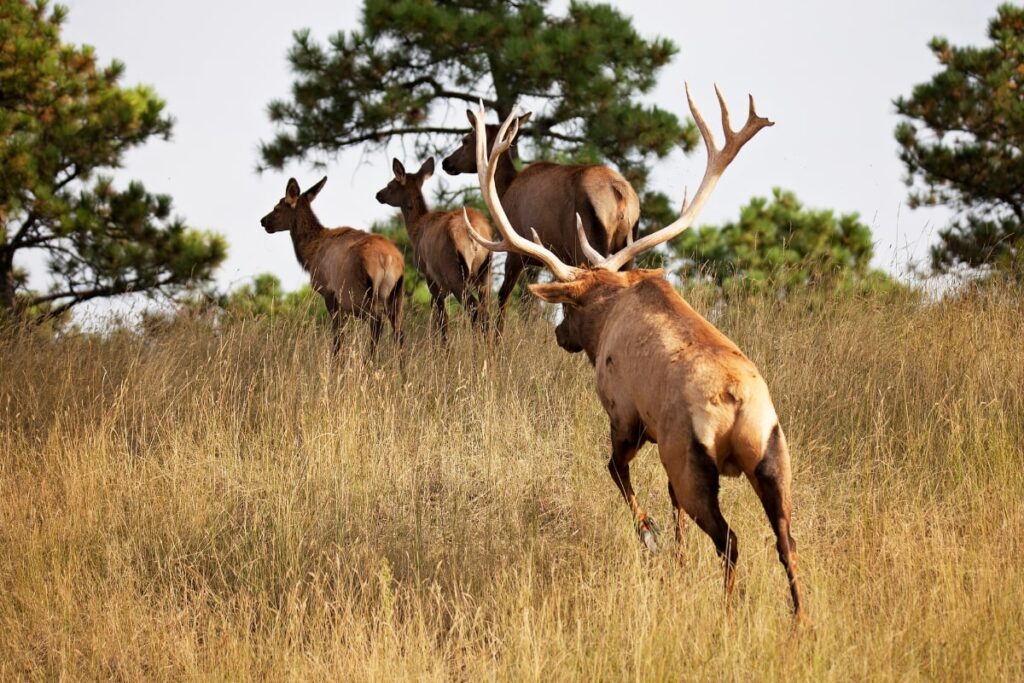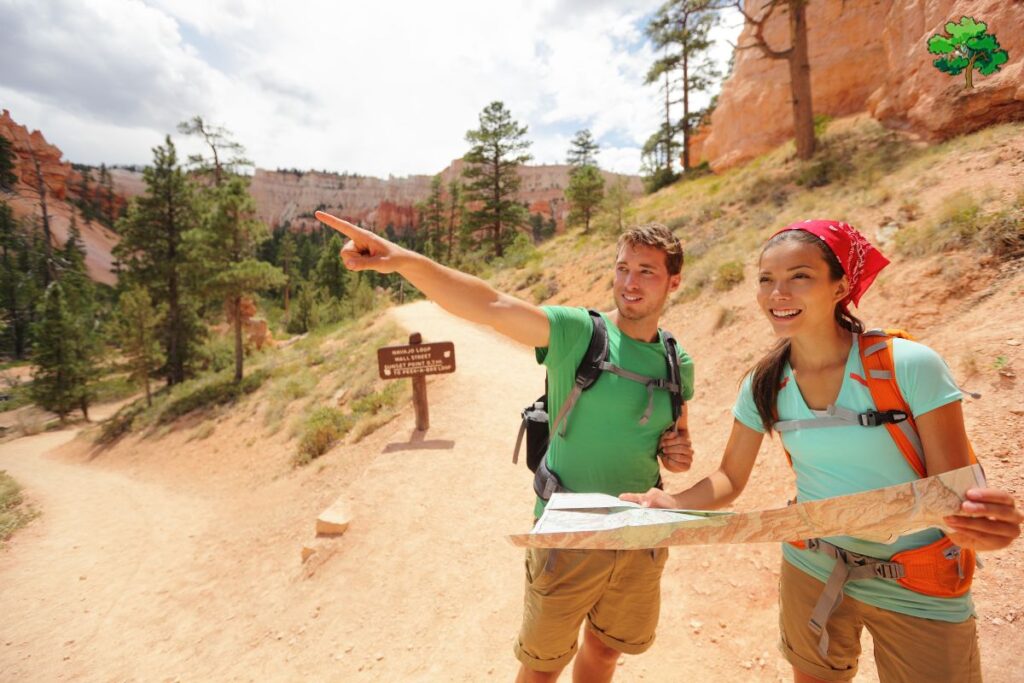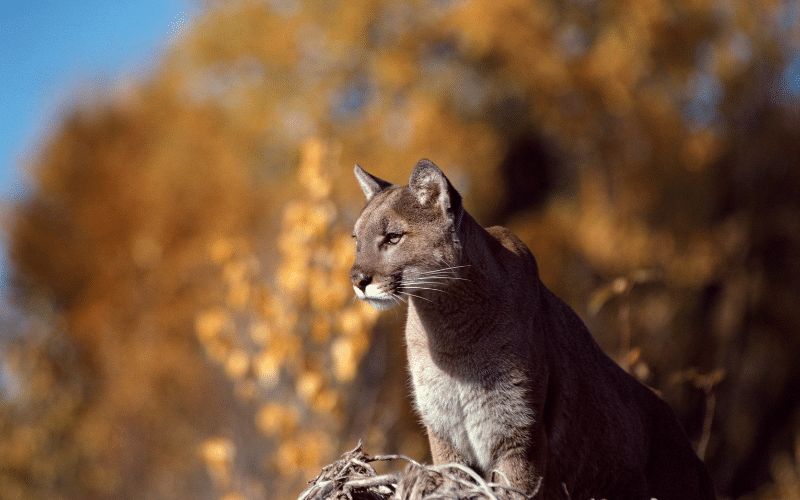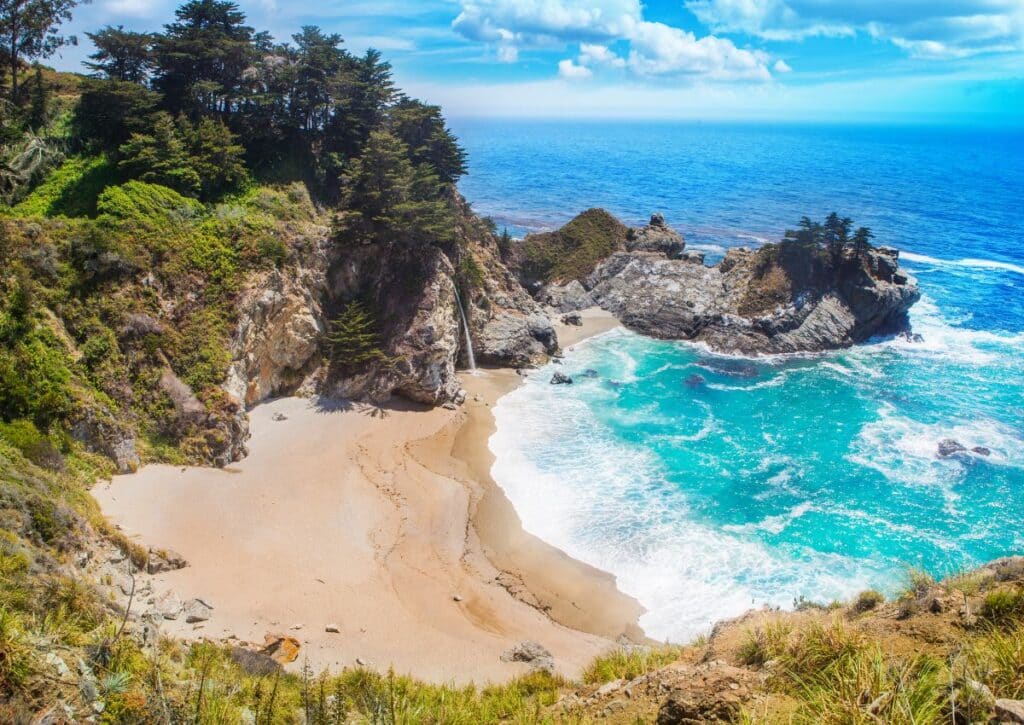Embark on our journey through 23 amazing US locales for unforgettable wildlife encounters! Tips & photos await.
Get ready to mark your maps and pack your gear! We’ve trekked across America’s wild spaces to bring you 23 must-visit hotspots for the best wildlife encounters. From the geyser-gushing grounds of Yellowstone to the gator-filled marshes of the Everglades, we’re your guides on this cross-country wildlife safari.
Think of this as your treasure map to nature’s hidden gems, where you’ll come nose-to-snout with creatures great and small. We’ll lead you through the hushed forests where bears roam, over the craggy peaks eagles call home, and into the depths of oceans where seals play peek-a-boo.
But this isn’t just about where to go; it’s about when to visit, what to bring, and how to spot the shy critters or the show-offy ones. Ready for the thrill of the wild? Let’s dive into the heart of America’s wilderness!
Yellowstone National Park (Wyoming, Montana, Idaho)
Yellowstone National Park is more than just scenic vistas and geothermal wonders; it’s a sprawling sanctuary where diverse wildlife freely roams.
Here, the majestic bison and elegant elk graze the meadows, while grizzly bears and gray wolves tread cautiously through dense woods.
Throughout the year, each season paints a unique backdrop for wildlife encounters. As winter’s chill recedes, the park comes alive with animals showcasing their spring rituals.
Summers see an influx of bird species, making it a haven for avian enthusiasts.
Fall, with its muted colors, is a perfect time to observe the park’s larger mammals as they prepare for the colder months.
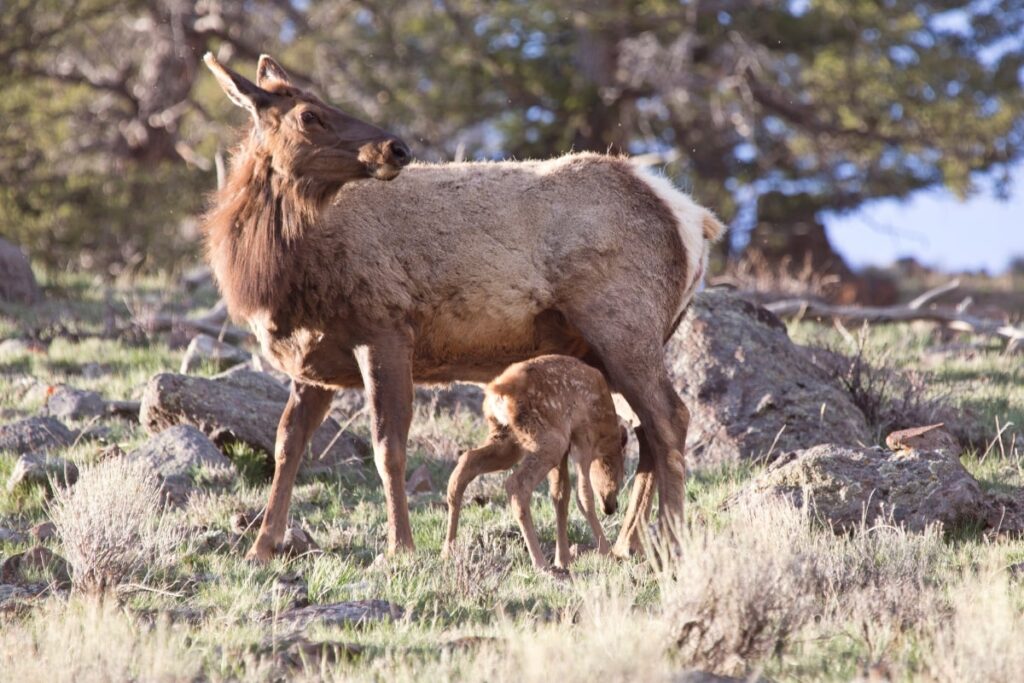
The Old Faithful geyser is a spectacle in its own right, the nearby Firehole River offers sightings of trumpeter swans, bald eagles, and ospreys.
Key Spots and Wildlife Encounters:
Lamar Valley: Observe wolves, bison, and pronghorn in this wildlife-rich area.
Hayden Valley: Spot bears, bison, and coyotes against the backdrop of a picturesque landscape.
Old Faithful: Enjoy the famous geyser and look for trumpeter swans, bald eagles, and ospreys near the Firehole River.
Quick Tips
Attend ranger-led programs for expert wildlife insights.
Practice safe wildlife viewing by maintaining a respectful distance.
Also Read: 7 UNFORGETTABLE VIATOR TOURS IN YELLOWSTONE FOR AN EPIC SPRING ADVENTURE!
Yosemite National Park (California)
Within the Sierra Nevada mountains of California, Yosemite National Park presents a harmonious blend of majestic landscapes and vibrant wildlife.
The park’s charm isn’t just confined to its grand granite cliffs, shimmering waterfalls, and ancient sequoias.
Instead, it extends to the mule deer seen leisurely grazing, the elusive bobcats that navigate the terrain, the peregrine falcons that grace the skies, and the chorus of owls that serenade the setting sun.
As the calendar pages turn, each season unfurls a new chapter of wildlife encounters.
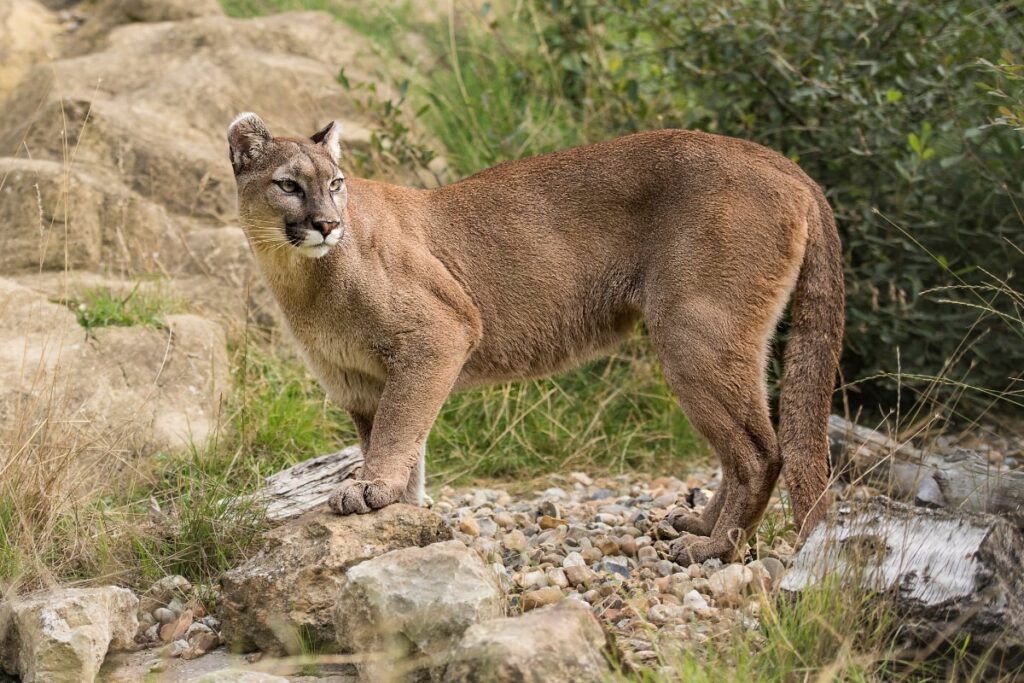
Key Wildlife Sighting Areas in Yosemite:
Yosemite Valley Meadows: These lush expanses are not just picturesque but are also teeming with wildlife, especially during the tranquil moments of dawn and dusk.
Tuolumne Meadows: Positioned at a higher elevation, these meadows are frequented by marmots basking on sunlit rocks and pikas with their unmistakable calls.
Merced River: Beyond its scenic allure, the riverbanks become a playground for various birds, curious deer, and, if you’re lucky, playful river otters.
Trails for Wildlife Viewing:
Mirror Lake Trail: A relatively easy hike, this trail often rewards visitors with sightings of deer and birds against the backdrop of the serene Mirror Lake.
Valley Loop Trail: Traversing through diverse habitats, this trail offers chances to spot a range of animals, from squirrels to the occasional bear.
Mist Trail: As you hike alongside the roaring waterfalls, keep an eye out for the smaller wonders, including diverse birds and amphibians near the water.
Enrich your Yosemite experience further with ranger-led programs, which offer a deep dive into the park’s rich biodiversity. But remember, these magnificent creatures are in their natural home. It’s crucial to admire from a respectful distance, ensuring mutual safety and wonder.
Also Read
8 FAVORITE YOSEMITE HIKES & BACKPACKING ADVENTURES WITH VIATOR TOURS!
YOSEMITE NATIONAL PARK: 40 TOP GUIDED TOURS TO EXPLORE THIS MAJESTIC PARK!
Great Smoky Mountains National Park (Tennessee, North Carolina)
Cradled between Tennessee and North Carolina, the Great Smoky Mountains National Park is a realm of mist-covered peaks and densely wooded slopes.
While the undulating topography and vibrant foliage are a sight to behold, the park’s true treasure lies in its abundant wildlife.
Black bears, white-tailed deer, and wild turkeys are just a few of the residents that animate these ancient mountains.
As the seasons transition, so does the park’s ambiance and its wildlife interactions.
Springtime wildflowers become a playground for butterflies and bees, summer’s warmth draws animals to freshwater streams, autumn showcases a flurry of bird migrations, and winter reveals tracks in the snow narrating tales of nocturnal adventures.
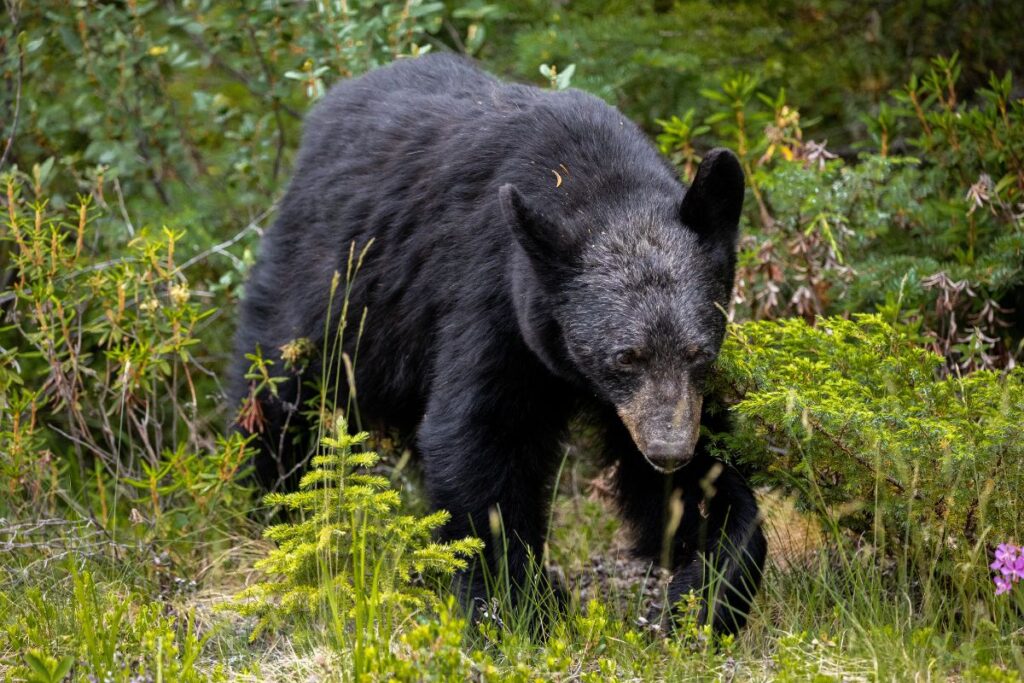
Key Wildlife Sighting Areas in Great Smoky Mountains:
Cades Cove: Renowned as a wildlife viewing hotspot, this valley offers glimpses of deer in the fields, black bears roaming the woods, and the possibility of a coyote or two as the sun sets.
Roaring Fork Motor Nature Trail: Meandering through dense forests, this trail provides opportunities to spot bears, wild turkeys, and an array of native birds.
Oconaluftee River Valley: Close to the park’s entrance, this picturesque valley becomes a gathering spot for elk, particularly during the cooler hours of dawn and dusk.
Trails for Wildlife Viewing:
Grotto Falls Trail: Traverse through old-growth hemlock forests, a haven for bird enthusiasts and a potential spot to see smaller mammals rustling through the underbrush.
Deep Creek Trail: The waterside path can be a delight for otter sightings, and the damp environment is perfect for spotting various salamanders.
Appalachian Trail: This extensive trail offers varying landscapes within the park, and each stretch has its unique set of wildlife, complemented by stunning mountain views.
Tips for Great Smoky Mountains:
Stay Bear Aware: The Smokies have a significant black bear population. Always store food and waste properly to avoid attracting them. If you encounter one, remain calm, avoid direct eye contact, and back away slowly.
Elk Etiquette: Especially in the Oconaluftee area, maintain a safe distance from elk. They might appear calm but can be unpredictable. It’s recommended to stay at least 50 yards away.
Wildflower Blooms: The park boasts over 1,500 types of flowering plants. If visiting during spring, take guided wildflower walks, often organized by the park, to learn about the region’s unique flora and its pollinators.
Remember, these mountains and forests are home to the wildlife you’re eager to see. Respecting their space ensures their safety and enriches your viewing experience.
Read More
30 TOP THINGS TO DO IN GREAT SMOKY MOUNTAINS NATIONAL PARK
GREAT SMOKY MOUNTAINS NATIONAL PARK: 6 TRAILS ON AN EXCITING GUIDED TOUR!
Grand Teton National Park (Wyoming)
In the expansive landscapes of Wyoming lies the dynamic world of Grand Teton National Park. Here, each season unveils a new chapter in the rich tapestry of its wildlife drama, framed by jagged peaks and tranquil valleys.
The moose stands as a testament to the wild spirit of Grand Teton. This majestic creature, particularly abundant here, becomes even more of a spectacle against the backdrop of the changing seasons.
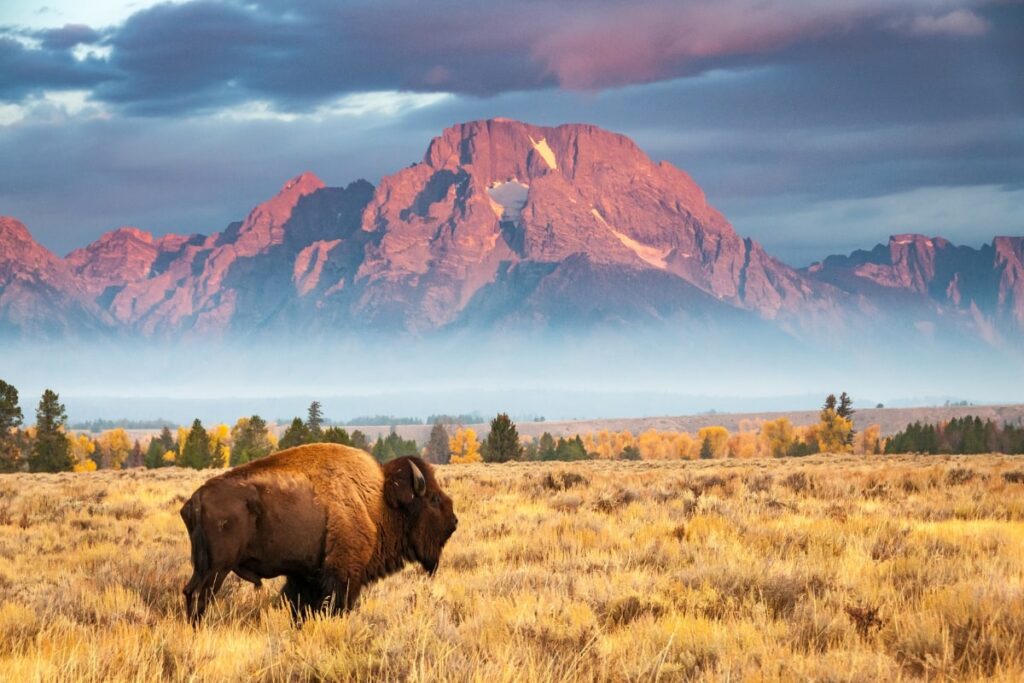
May is a fantastic time to visit, as the park’s snow-covered peaks provide a stunning backdrop for wildlife sightings.
Key Spots and Wildlife Encounters:
In Jackson Hole Valley, spring breathes life, with blossoming meadows that attract herds of elk and pronghorns. As the valley warms up in summer, it becomes a lively stage of activity, with creatures big and small basking under the sun or seeking shade. Autumn transforms the valley into a golden realm, with the sounds of elk rutting echoing in the crisp air. And then comes winter, a time of stillness, with a blanket of snow subtly hinting at the life beneath and around.
The meandering Snake River provides a constant, life-sustaining force throughout the year. In summer, its waters teem with playful otters, while in fall, its banks witness animals preparing for the colder months ahead.
Jenny Lake, a shimmering jewel of the park, mirrors the seasonal dance. Its shores are abuzz with mule deer, foxes, and birds in the warmer months. As winter sets in, the tranquil snowscape becomes a silent observer to nature’s subdued moments.
The Taggart Lake Trail invites visitors on a journey through the seasons. Spring and summer offer a vibrant display of flora and fauna, while autumn adds a golden touch. Winter, with its snow-covered paths, presents an entirely different, serene world.
Quick Tips
Visitors venturing into this wilderness should always be prepared. Spring’s beauty comes with its caution, as newborn wildlife and their protective mothers roam the park.
Summer’s warmth is accompanied by heightened bear activity, making bear awareness crucial.
Autumn offers the magnificent sight of elk rutting, but safety should be the priority. And winter, in all its quiet glory, demands respect for its icy terrains and hidden inhabitants.
Read More: EXPLORING GRAND TETON NATIONAL PARK: 6 STARTING POINTS (A 2023 GUIDE)
Denali National Park (Alaska)
Denali National Park, spread over 6 million acres in Alaska, is home to North America’s tallest peak, Denali, standing at 20,310 feet. The park’s vast landscapes range from low elevation taiga forests to high alpine tundras and snowy mountains, making it a diverse habitat for wildlife.
The park’s most iconic resident is the gray wolf. With a population that fluctuates but remains in the low hundreds, spotting one is a highlight for many visitors.
Denali also boasts one of the healthiest populations of grizzly bears in North America, often seen foraging or playing in open spaces.
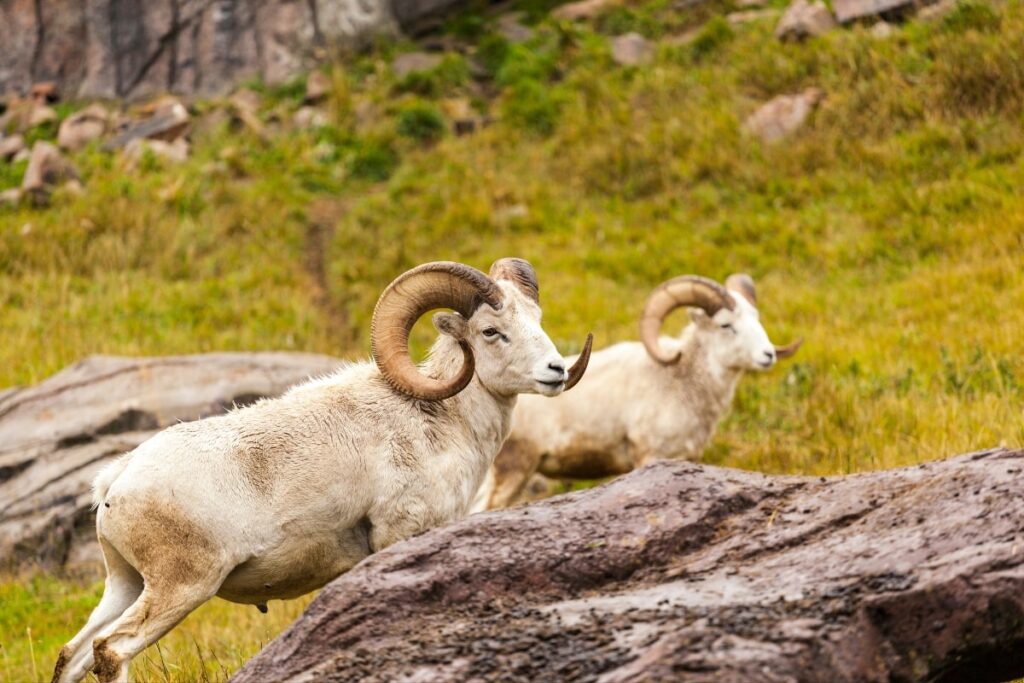
Key Spots and Wildlife Encounters:
Tolklat River is renowned for caribou sightings. These animals, with their majestic antlers, migrate across the park and are frequently seen wading or drinking from the river’s channels. Grizzly bears also frequent the riverbanks, especially during salmon spawning seasons.
The Polychrome Overlook provides more than just stunning terrains; it’s one of the best places in the park to spot the white dall sheep against the contrasting multi-hued volcanic rocks.
For hikers, the Mount McKinley Bar Trail is both a challenge and a reward. While the trail showcases unparalleled views of Denali, it’s also a hotspot for wildlife, from the swift red foxes to the burrowing marmots and, if luck is on your side, the elusive lynx.
Quick Tips
A visit to Denali demands preparation. The park experiences long daylight hours in summer due to its northern latitude, resulting in extended wildlife activity.
Packing for unpredictable weather is crucial, as temperatures can vary significantly within a single day. Lastly, remember that in Denali, human visitors are the guests. Maintaining a safe distance from wildlife ensures the safety of both animals and park-goers.
Denali offers an immersive experience into one of the last true wild frontiers of North America, a place where nature dictates the rhythms and humans are but silent observers.
Read More: 10 INCREDIBLE NATIONAL PARKS TO SEE MALE BLACK BEARS EMERGE FROM HIBERNATION!
Everglades National Park (Florida)
At the southern tip of Florida lies Everglades National Park, a vast and unique subtropical wetland ecosystem teeming with diverse wildlife. The park stretches over 1.5 million acres, offering visitors a deep dive into a complex interplay of marine and terrestrial habitats.
The allure of the Everglades isn’t solely in its iconic sawgrass marshes and mangrove forests.
It’s in the silent approach of the American alligator, the graceful flight of the roseate spoonbill, the stealthy prowl of the Florida panther, and the distant call of the elusive mangrove cuckoo.
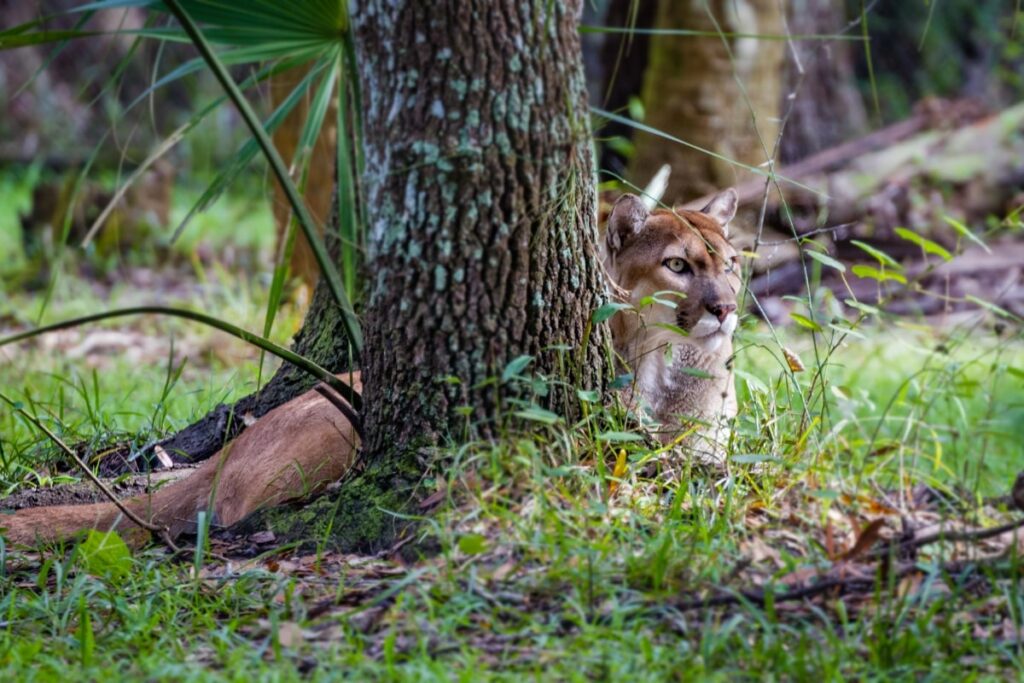
Each season reveals a distinct face of the Everglades, shaping the behavior and movement of its residents.
Key Spots and Wildlife Encounters:
Shark Valley: A panoramic view of the Everglades can be found here, with frequent sightings of alligators, wading birds, and turtles, especially during the cooler mornings.
Anhinga Trail: Named for the often-spotted Anhinga bird, this area is a hotspot for diverse bird species and showcases the park’s rich aquatic life.
Flamingo Marina: Overlooking Florida Bay, it’s a hub of activity. One can spot manatees in the warmer waters, crocodiles sunning themselves, and a myriad of bird species fishing in the shallows.
Pine Island Trail: Nestled amidst pineland habitats, this trail introduces visitors to the park’s terrestrial wildlife, including gopher tortoises and the occasional bobcat.
Mahogany Hammock Trail: Winding through a dense hardwood hammock, this trail is an excellent place to spot tropical birds and get glimpses of tree-dwelling creatures.
Pa-hay-okee Overlook: Offering expansive views of the park’s vast sawgrass prairies, this boardwalk might treat you to sights of wading birds in the distance and alligators closer to the boardwalk.
Quick Tips
Insect Protection: The park is often called the “River of Grass,” but with the grass comes mosquitoes. Equip yourself with insect repellent and light-weight long-sleeve clothing.
Stay Hydrated: Florida’s heat, especially in summer, can be oppressive. Carry ample water and wear sun protection.
Boat Tours: For a unique perspective, consider guided boat tours which offer both wildlife viewing and insights into the park’s ecology.
Safe Wildlife Viewing: While it’s tempting to get a closer look, maintain a safe distance from alligators and nesting birds. Crocodiles, though rarer, are even less predictable than alligators. Always adhere to safety guidelines.
Check Water Levels: If you’re planning on canoeing or kayaking, check current water levels. The Everglades can be shallow, affecting navigation.
Olympic National Park (Washington)
Olympic National Park in Washington showcases a remarkable range of natural beauty. Here, you can find everything from the Pacific coastline’s rough edges to dense rainforests and towering mountain peaks. It’s where three different ecosystems come together.
This park is home to a variety of wildlife. You might see Roosevelt elk in the Hoh Rainforest, river otters by Lake Crescent, marmots in the high meadows, or bald eagles flying along the coast.
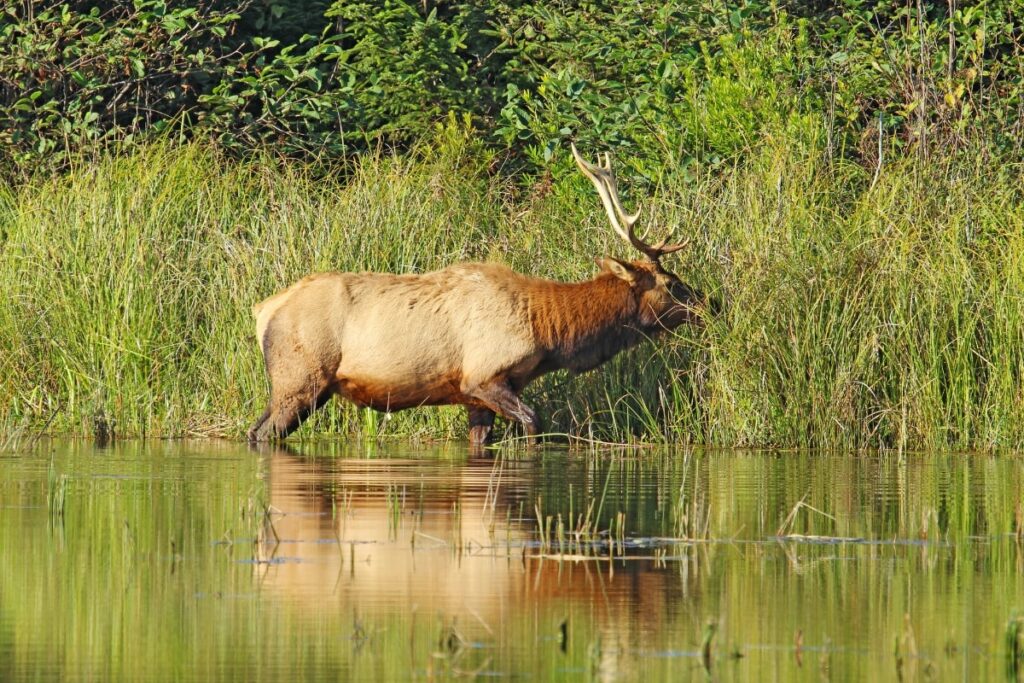
As the seasons change, the park’s wildlife adapts, offering visitors a fresh experience throughout the year.
Key Spots and Wildlife Encounters:
Hoh Rainforest: Venture into this green cathedral and be on the lookout for Roosevelt elk, black-tailed deer, and an impressive array of bird species.
Rialto Beach: Along this rugged coastline, tide pools house colorful sea stars and anemones, while the horizon may grant glimpses of passing whales.
Hurricane Ridge: At higher elevations, black-tailed deer, marmots, and mountain goats can be seen traversing the landscape, particularly during the warmer months.
Sol Duc Valley Trail: As you wander through ancient forests, the sounds of the Sol Duc River accompany sightings of various woodland creatures and the occasional elk herd.
Ozette Loop: This coastal trail unveils a delicate balance between land and sea. Seals, sea lions, and otters can be spotted, especially during early mornings or late afternoons.
Staircase Rapids Loop: A perfect family-friendly trail, it’s known for birdwatching opportunities and the playful antics of river otters.
Quick Tips
- Tide Timings: If exploring the coastal areas, be aware of the tide timings. Certain wildlife, especially in tide pools, is best viewed during low tide.
- Weather Preparedness: The park’s diverse ecosystems mean varying weather conditions. Waterproof gear is a must, especially in the rainforest regions.
- Bear Safety: Black bears inhabit the park. Store food properly and maintain a safe distance while viewing.
- Guided Tours: Join ranger-led programs to delve deeper into the intricate ecosystems and the stories they hold.
- Conservation Respect: Many areas in Olympic are delicate habitats. Stay on marked trails and respect all wildlife, ensuring minimal impact on their natural environments.
Rocky Mountain National Park (Colorado)
Rocky Mountain National Park in Colorado is a landscape dominated by towering peaks and sweeping valleys. It’s a place where pristine rivers flow, alpine meadows flourish, and dense forests cast deep shadows.
Within this breathtaking terrain, wildlife thrives. Herds of elk roam the meadows, bighorn sheep navigate the rocky cliffs, mule deer wander through the forests, and above, eagles and hawks rule the skies.
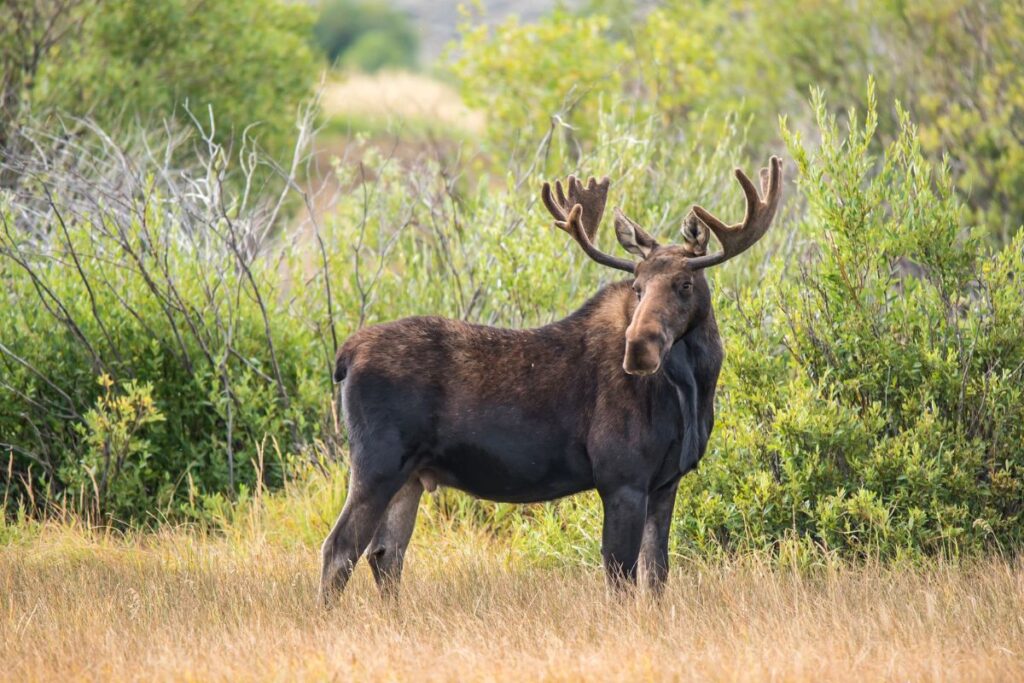
As seasons roll from one to the next, the park undergoes dramatic changes, influencing both the landscapes and the animals that call it home.
Key Spots and Wildlife Encounters:
Moraine Park: A hotspot for elk, especially during the rutting season when their bugling calls resonate through the valley.
Trail Ridge Road: This high-elevation road offers views of marmots, pika, and occasionally, bighorn sheep against a backdrop of spectacular mountain vistas.
Bear Lake: Nestled amidst dense woods, this lake area is frequented by various birds, mule deer, and sometimes, moose.
Cub Lake Trail: Passing through meadows and forests, hikers can often spot elk, mule deer, and a variety of birds.
Emerald Lake Trail: As you climb to higher altitudes, watch for alpine animals like the marmot and pika, along with stunning lake views.
Quick Tips
- Elevation Awareness: The park’s high altitudes can affect visitors. Stay hydrated and take things slow, especially if you’re not acclimated.
- Drive Slowly: Wildlife is frequently spotted near or on roads. Drive with caution, especially during dawn and dusk.
- Weather Preparedness: Mountain weather can be unpredictable. Bring layers and be prepared for sudden changes, especially at higher elevations.
- Bear Safety: The park is home to both black and brown bears. When hiking, make noise to alert wildlife of your presence and always keep a safe distance.
Acadia National Park (Maine)
Acadia National Park, situated along Maine’s rugged coastline, is a mesmerizing blend of land and sea.
The park offers craggy cliffs that plunge into the North Atlantic, dense woodlands that echo with the calls of diverse birdlife, and serene lakes reflecting the clear blue skies.
Among its scenic vistas, a vibrant community of wildlife flourishes.
White-tailed deer forage in the undergrowth, peregrine falcons dive from mountaintops, seals bask on coastal rocks, and the haunting calls of loons float across its freshwater lakes.
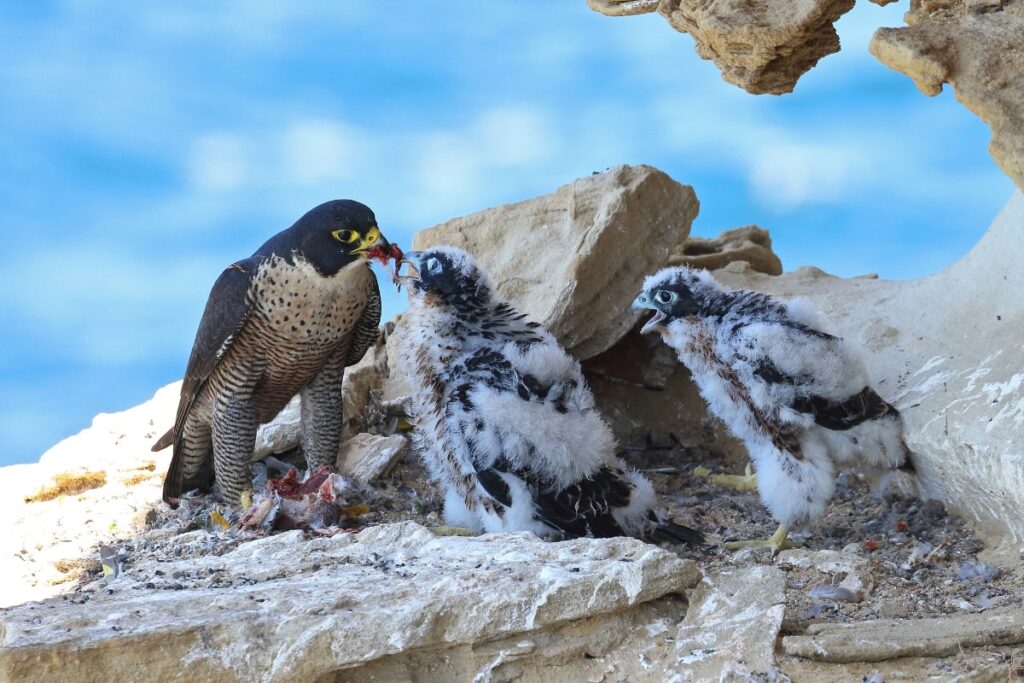
Key Spots and Wildlife Encounters:
Jordan Pond: This iconic location not only provides stunning landscapes but also opportunities to see beavers, otters, and a myriad of bird species around the water.
Cadillac Mountain: The highest point on the East Coast, it offers panoramic views and chances to spot raptors and ground-nesting birds.
Schoodic Peninsula: A quieter part of Acadia, it’s an excellent place to watch seabirds, seals, and occasionally, whales in the distance.
Precipice Trail: Though challenging, this trail is known for peregrine falcon sightings, especially during nesting seasons.
Jordan Pond Path: A gentle trail that circles the pond, offering frequent encounters with waterfowl, amphibians, and small mammals.
Ship Harbor Nature Trail: This trail takes you through a mix of forest and coastline, making it a prime spot to witness both terrestrial and marine life.
Quick Tips
- Tidal Zones: Exploring tide pools can be fascinating. Remember to check tide schedules to maximize your experience and ensure safety.
- Dawn & Dusk: These times often present the best opportunities for wildlife viewing, especially for animals like deer and foxes.
- Respect Nesting Birds: Some areas may be temporarily closed due to nesting birds, particularly peregrine falcons. Adhere to these restrictions to protect the species.
- Drive Cautiously: The park loop road offers beautiful views but can also be a crossing point for animals. Always be alert.
Big Bend National Park (Texas)
In the vast expanse of West Texas, Big Bend National Park emerges as an oasis of diversity. The park stretches over the Chihuahuan Desert, with the mighty Rio Grande carving its southern boundary and the Chisos Mountains rising majestically amidst it all.
Such varied landscapes foster a unique array of wildlife.
From the roadrunners dashing across the desert plains to the black bears wandering the mountainous woodlands, and the aquatic life teeming in the Rio Grande, Big Bend is a microcosm of nature’s wonders.
Nightfall even welcomes an impressive display as bats take to the skies in their thousands.
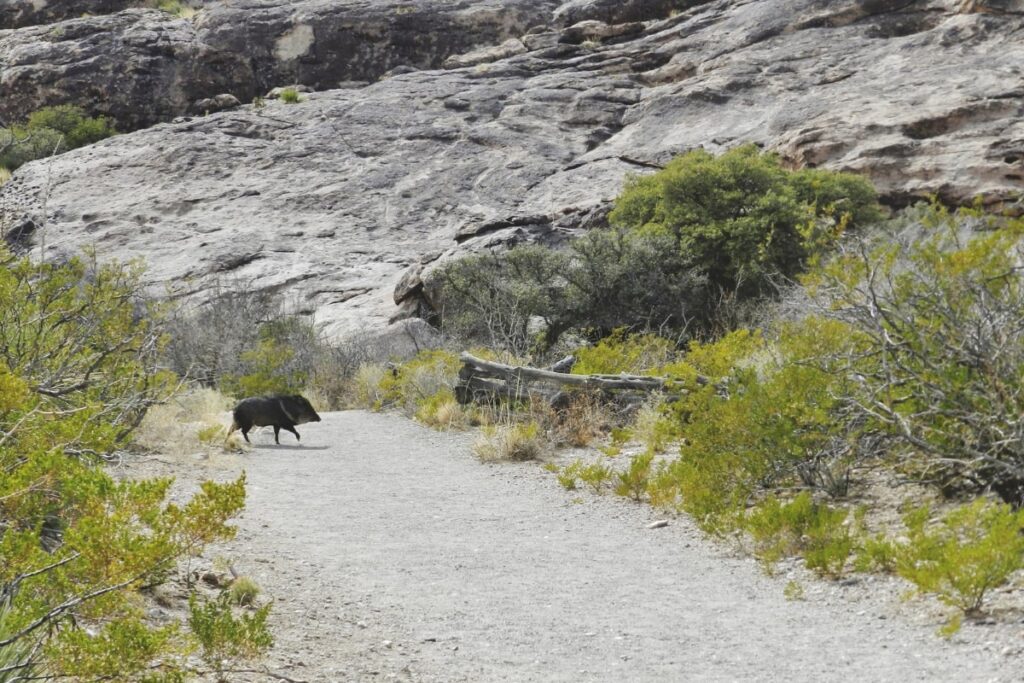
May is a prime time for birdwatching, as migratory species pass through the park.
Key Spots and Wildlife Encounters:
Santa Elena Canyon: This breathtaking canyon on the Rio Grande is a hotspot for bird watching, especially during migrations.
Chisos Basin: Located at higher elevations, this area is cooler and offers sightings of deer, javelinas, and even mountain lions if you’re fortunate.
Rio Grande Village: Along the riverbanks, you might spot beavers, turtles, and a host of water birds
Lost Mine Trail: Leading to a fantastic viewpoint, this trail is also known for birdwatching and occasional deer sightings.
Window View Trail: A shorter walk, great for spotting various bird species, especially in the early morning or late afternoon.
Boquillas Canyon Trail: As you walk along the Rio Grande, keep an eye out for the diverse birdlife and other river-associated creatures.
Quick Tips
- Stay Hydrated: The desert environment can be deceptively arid. Always carry plenty of water and protect yourself from the sun.
- Flash Flood Awareness: If exploring canyons or washes, be aware of the weather as flash floods can occur.
- Night Sky: Big Bend is known for its dark skies. After watching the wildlife, turn your gaze upwards for some stargazing.
- Border Safety: As the park shares a boundary with Mexico, be aware of border crossings and stick to designated areas.
Big Bend National Park stands as a testament to the resilience of nature in the face of harsh conditions.
Every crevice, river bend, and peak here holds stories of the creatures that have adapted to call it home.
Custer State Park (South Dakota)
South Dakota’s Custer State Park is a true gem of the Midwest, a sprawling haven that beautifully showcases the ruggedness and serenity of the Black Hills region.
Spanning 71,000 acres, this park stands out for its unique granite formations, lush grasslands, and pristine lakes. But its charm isn’t only in the landscapes—it thrives in the form of its remarkable wildlife.
The iconic scene of bison herds roaming freely across the plains is a vision many associate with the American West, and in Custer State Park, it’s a reality.
Apart from bison, you can witness pronghorns sprinting across fields, elk grazing by the forests, and burros curiously approaching visitors.
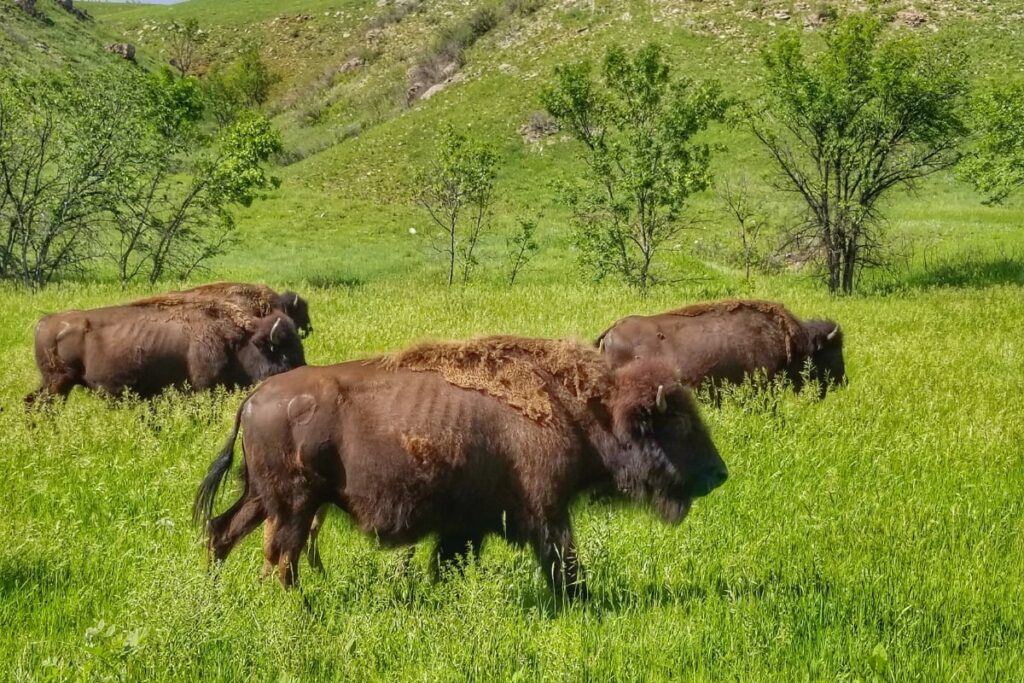
May is a fantastic time to visit, as newborn animals make their debut and the park’s flora comes to life.
Key Spots and Wildlife Encounters:
Wildlife Loop Road: Drive this scenic route for encounters with bison, pronghorn, and prairie dogs.
Sylvan Lake: Look for white-tailed deer, bighorn sheep, and a variety of bird species around this picturesque lake.
Grace Coolidge Walk-In Fishing Area: Observe beavers, muskrats, and waterfowl along the creek.
Quick Tips
- Driving Caution: Bison jams are frequent, especially around the Wildlife Loop Road. Maintain a safe distance and don’t rush these majestic creatures.
- Picnicking: When enjoying a meal outdoors, always clean up to ensure wildlife doesn’t get access to human food.
- Camping Safety: If you’re camping, be aware that you’re in wildlife territory. Secure your food and belongings.
- Guided Tours: Consider joining ranger-led wildlife walks to gain deeper insights into the park’s ecology and inhabitants.
An immersion into Custer State Park is a journey into the heart of America’s great plains. It offers a perfect mix of exploration and tranquility, with the added thrill of close encounters with some of the nation’s most iconic wildlife.
Myakka River State Park (Florida)
In the sun-drenched landscape of Florida’s Gulf Coast lies Myakka River State Park, one of the state’s oldest and largest parks. Stretching over 37,000 acres, the park offers a vibrant mosaic of wetlands, prairies, hammocks, and pinelands.
But what truly captivates the hearts of visitors is the diverse wildlife that inhabits this verdant paradise.
The park is a sanctuary for a plethora of species, from the American alligators that dominate its waterways to the elegant wading birds like roseate spoonbills and herons. Deer roam the uplands, while the calls of ospreys echo overhead.
The rich waters are not just home to alligators but also house a variety of freshwater fish, drawing anglers from near and far.
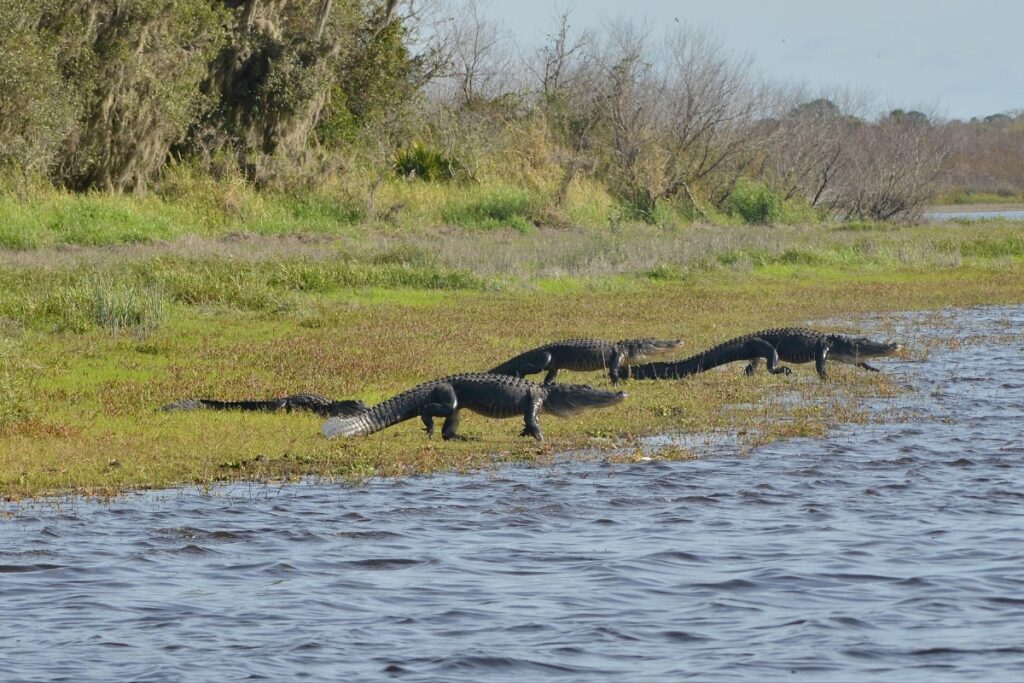
Key Spots and Wildlife Encounters:
Myakka Lake: A massive freshwater lake, it’s the epicenter of the park’s aquatic life, where alligators, turtles, and myriad bird species thrive.
Canopy Walkway: Offering a bird’s-eye view of the park’s treetops, this suspended bridge lets you observe avian life from an elevated perspective.
The Birdwalk: A boardwalk extending into the marsh, providing unobstructed views of wading birds, ducks, and the occasional otter.
Myakka River Trail: Skirting the river, this trail is your best bet for spotting alligators, water birds, and even bobcats.
Prairie Loop Trail: Taking you through flatwoods and wet prairies, look out for deer, wild turkeys, and the vibrant hues of countless butterflies.
Big Slough Nature Trail: Perfect for a tranquil walk, this trail is frequented by birds, and you might also spot tracks of raccoons and other nocturnal creatures.
Quick Tips
- Water Safety: Alligators are wild animals. Maintain a safe distance, and never feed or provoke them. Avoid swimming in undesignated areas.
- Bug Repellant: Being a wetland ecosystem, the park has mosquitoes. It’s wise to wear repellant, especially during dawn and dusk.
- Boat Tours: To experience the park’s waterways and see its wildlife up close, consider joining a guided boat tour.
- Bird Watching: With its array of bird species, carrying a bird guidebook or app can enhance your experience.
Red Rock State Park (Arizona)
Amidst the scorching landscapes of Arizona lies an oasis of stunning vistas and teeming wildlife: Red Rock State Park. Painted in hues of fiery reds and deep oranges, this park showcases the iconic red rock formations that Arizona is renowned for.
Yet beyond its geological marvels, the park is a thriving habitat where the rhythm of nature plays out daily.
It’s not just the scenic views that captivate visitors, but the park’s unique desert inhabitants. Birds like the vermilion flycatcher and black-throated sparrow find solace here.
Mule deer navigate the terrains with ease, while the cautious footsteps of the javelina can be traced back to the underbrush.
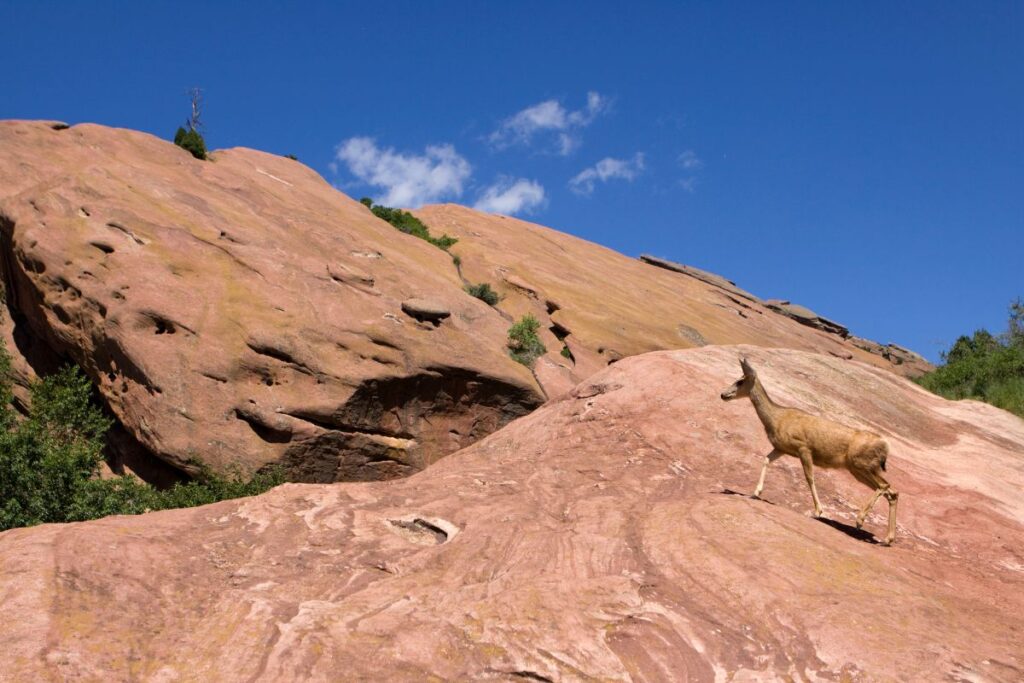
Key Spots and Wildlife Encounters:
Oak Creek: The life-giving waters of Oak Creek attract a plethora of wildlife, from beavers creating their habitats to various birds quenching their thirst.
Kisva Trail: This trail offers panoramic views and frequently hosts the graceful flights of raptors and the occasional prancing deer.
Eagle’s Nest Loop: A higher vantage point, this loop provides glimpses of the diverse bird species that call the park home.
Smoke Trail: As you tread this path, keep an eye out for lizards basking on the rocks and the occasional roadrunner darting past.
Coyote Ridge Trail: Here, the signs of larger mammals, like javelinas or bobcats, might present themselves, especially during the cooler hours of dawn or dusk.
Tips for Your Red Rock State Park Visit:
- Hydration: The Arizonian sun can be relentless. Always carry ample water and wear sun protection, even on shorter hikes.
- Desert Etiquette: Many of the park’s inhabitants are adapted to its delicate ecosystem. Tread lightly, stick to marked paths, and leave no trace.
- Flash Floods: If visiting during monsoon season, be cautious of sudden weather changes and avoid low-lying areas.
- Guided Tours: Join park ranger-led tours to gain insights into the unique geology and biodiversity of the park.
Red Rock State Park is more than just an exhibition of Arizona’s geological prowess. It’s a testament to the resilience of nature, where life flourishes against the odds, presenting visitors with a harmonious blend of rugged beauty and diverse wildlife.
Point Lobos State Natural Reserve (California)
Perched along the rugged central coast of California, Point Lobos State Natural Reserve is a jewel of marine and terrestrial biodiversity.
Characterized by its rocky shores, cypress groves, and the serene blue of the Pacific, the reserve serves as both a gateway to the underwater world and a haven for land-dwelling creatures.
Point Lobos dazzles not only with its natural landscapes but with its abundant wildlife. Sea otters playfully float in the kelp beds, sea lions bark from their coastal perches, and gray whales can be spotted on their migratory journey.
On land, mule deer graze on the grasslands while the calls of various seabirds, including the rare Brandt’s cormorant, echo through the air.

Key Spots and Wildlife Encounters:
Whalers Cove: This serene bay is renowned for its underwater diversity, making it a hotspot for divers, but those on land can spot harbor seals, otters, and a myriad of bird species.
Cypress Grove Trail: Winding through one of the two naturally growing stands of Monterey cypress trees in the world, this trail is a prime spot for birdwatching and offers panoramic ocean views.
Sea Lion Point Trail: As the name suggests, this trail provides visitors with an up-close experience of sea lions, as they often haul out onto the rocks here.
Trails for Wildlife Viewing:
Bird Island Trail: Leading to a viewing area overlooking Bird Island, this trail offers chances to observe nesting birds, especially during spring and summer.
Pine Ridge Trail: Along this path, one might encounter mule deer, raccoons, and various bird species, all set against the backdrop of the Pacific Ocean.
Tips for Your Point Lobos State Natural Reserve Visit:
- Tidal Caution: The reserve’s beauty is intertwined with its tidal zones. If exploring tide pools or coastal areas, always be aware of tide timings to avoid getting stranded.
- Respect Marine Life: The temptation to approach marine animals can be strong, but it’s essential to view from a distance to avoid causing them stress or harm.
- Parking: Point Lobos can get crowded, especially during weekends. Arriving early or visiting on weekdays can help ensure a smoother experience.
- Guided Walks: To deepen your understanding of the reserve’s ecology, consider joining a docent-led walk. These guided tours provide a wealth of information and often reveal hidden gems of the park.
A visit to Point Lobos State Natural Reserve offers a blend of terrestrial and marine exploration. It’s a place where the rhythm of the ocean meets the pulse of the land, offering a symphony of natural wonders that captivate the heart and soul.
Brazos Bend State Park (Texas)
Deep in the heart of Texas, Brazos Bend State Park emerges as an enchanting blend of wetlands, prairies, and forests, crafting a mosaic of ecosystems where wildlife thrives.
With its serene lakes, winding trails, and dense woodlands, the park captures the essence of the Texan wilderness.
It’s not just the tranquillity of the park’s landscapes that draws visitors but its rich tapestry of wildlife. Brazos Bend is famously known for its American alligators, often seen basking by the water’s edge.
White-tailed deer graze the prairies, while the skies are animated with the presence of over 300 bird species, including the roseate spoonbill and the black-bellied whistling duck.
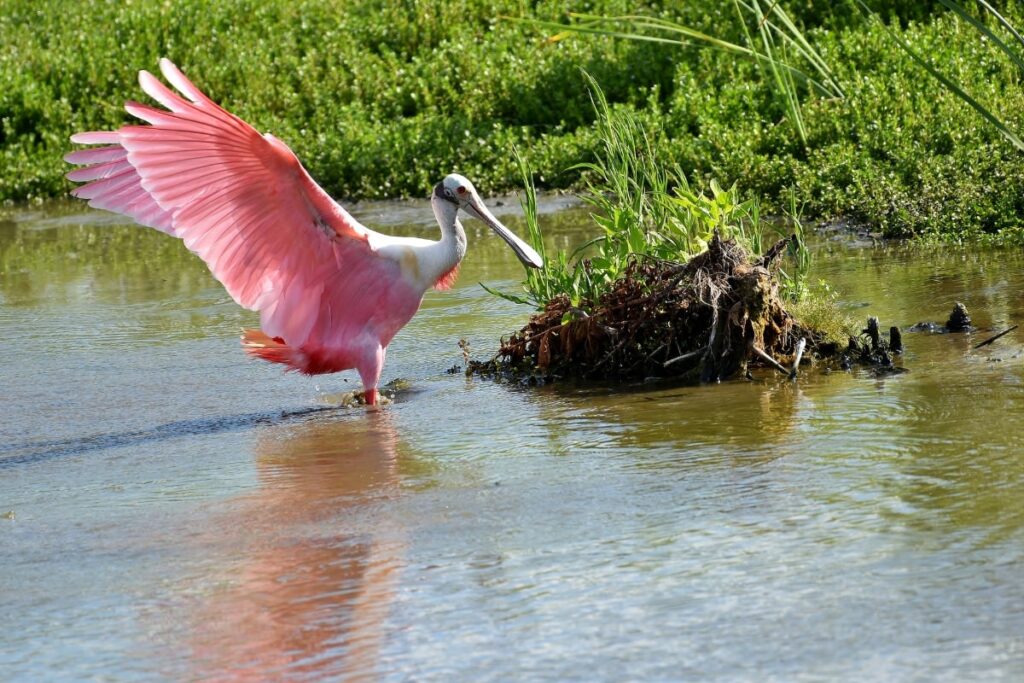
Key Spots and Wildlife Encounters:
Elm Lake: A prime location to spot alligators, turtles, and a plethora of bird species, its accessible boardwalks offer visitors panoramic views of the lake’s vibrant ecology.
40-Acre Lake: Another hotspot for alligator sightings, this lake’s surrounding trails also provide opportunities to encounter raccoons, armadillos, and various waterfowl.
Creekfield Lake: Beyond its calm waters, this lake is frequented by wading birds, and its trail is adorned with interpretive displays, making it an educational venture.
Trails for Wildlife Viewing:
Pilant Slough Trail: Venturing through diverse habitats, this trail is particularly active during dawn and dusk, with sightings of nocturnal creatures and early risers.
Big Creek Loop: Winding through the park’s forested areas, this loop provides chances to spot deer, owls, and the elusive bobcat.
Tips for Your Brazos Bend State Park Visit:
- Alligator Safety: While these reptiles are a prime attraction, maintaining a safe distance and not feeding them is crucial. Stay on designated trails and be cautious near water’s edge.
- Mosquito Preparedness: Being a wetland habitat, mosquitoes can be active. Bring repellents and wear appropriate clothing.
- Visit the Nature Center: To enrich your experience, stop by the park’s nature center, where exhibits offer insights into the local ecosystem, and rangers can provide valuable sighting tips.
- Night Hikes: The park often organizes guided night hikes, a unique way to experience the nocturnal side of Brazos Bend.
Brazos Bend State Park stands as a testament to Texas’s diverse landscapes, offering a wild retreat where nature unfolds its stories with every step. Whether it’s the silent gaze of an alligator or the cheerful calls of waterfowl, the park ensures a memorable embrace of the wild.
Pisgah National Forest (North Carolina)
Carved into the Appalachian Mountains, Pisgah National Forest showcases the rugged beauty and dense greenery for which North Carolina is renowned.
Sprawling over half a million acres, Pisgah is a mesh of cascading waterfalls, vast hardwood forests, and clear, serene streams — an idyllic setting that fosters a wide array of wildlife.
The heart of this forest is alive with creatures like the white-tailed deer, the eastern box turtle, and the beautiful blue ghost fireflies that illuminate the forest during certain times of the year.
Birdwatchers would revel in the sights and sounds of warblers, owls, and hawks that populate the dense canopy.
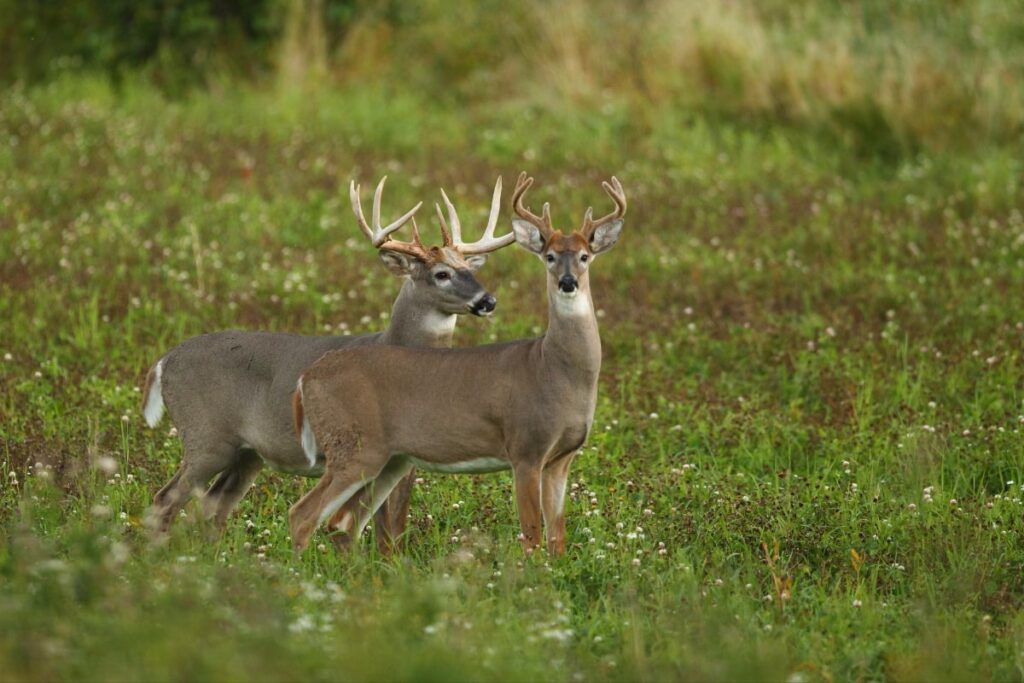
Key Spots and Wildlife Encounters:
Looking Glass Falls: Not only is it one of the most iconic waterfalls in North Carolina, but the surrounding area is also vibrant with wildlife, making it a dual attraction for nature lovers.
Sliding Rock: A natural waterslide that attracts both humans and animals, especially in warmer months. Keep an eye out for amphibians and birds in this lively spot.
Pink Beds Valley: A lush valley renowned for its biodiversity. The looping trail here offers an immersive experience with potential sightings of salamanders, birds, and deer.
Trails for Wildlife Viewing:
Craggy Gardens Trail: Renowned for its rhododendron blooms, it’s also a prime location to watch for high-altitude bird species and small mammals.
Black Balsam Knob: A part of the Art Loeb Trail, this section provides panoramic views and the chance to spot raptors and other high-flying birds against the backdrop of the Appalachian Mountains.
Tips for Your Pisgah National Forest Visit:
- Variable Weather: Due to its vast size and elevation changes, the weather in Pisgah can be unpredictable. It’s advised to carry layers and check weather forecasts, especially if hiking to higher elevations.
- Bear Precautions: Black bears are residents of these woods. Ensure food is stored properly, and be aware of your surroundings, especially when hiking during dawn or dusk.
- Wildflower Seasons: Spring and early summer are exceptional times to view the forest’s wildflowers. However, do remember to stay on marked trails to preserve the delicate ecosystem.
- Water Safety: If venturing near water bodies, be cautious of slippery rocks and sudden water surges, especially after rainfalls.
A journey through Pisgah National Forest is a symphony of nature’s sights and sounds. As you tread its paths and breathe in the fresh mountain air, every corner promises discovery, and every moment becomes a cherished memory.
Tongass National Forest (Alaska)
Tongass National Forest, the largest national forest in the United States, boasts a diverse array of wildlife such as bald eagles, brown bears, and Sitka black-tailed deer.
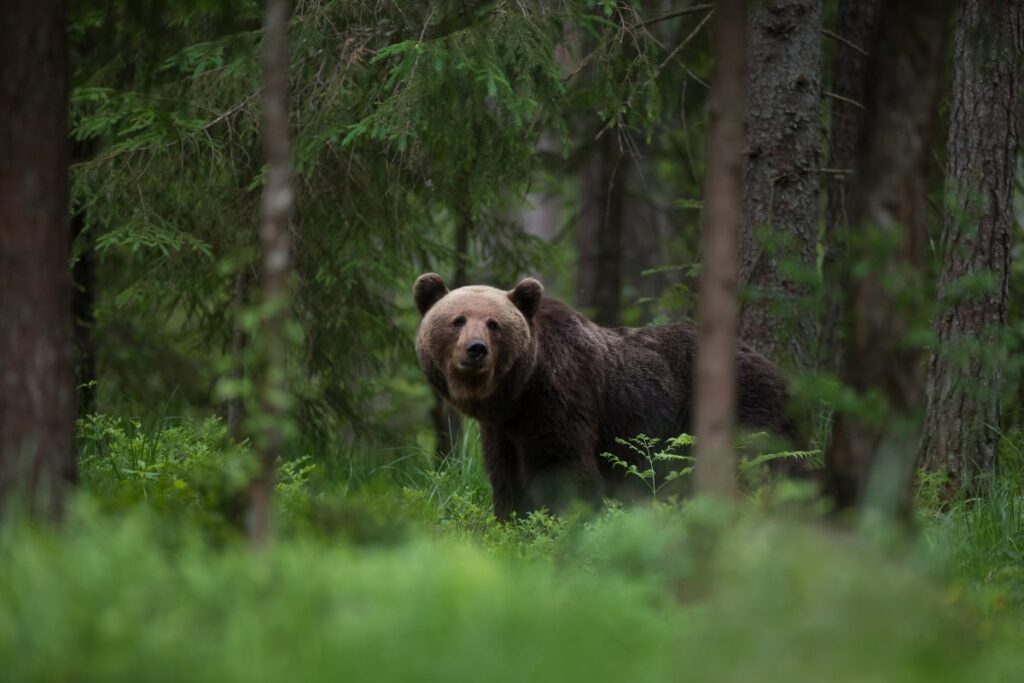
May is an excellent time to visit, as the forest awakens from its winter slumber and humpback whales begin to arrive.
Key Spots and Wildlife Encounters
Anan Wildlife Observatory: Observe brown bears and bald eagles fishing for salmon in this unique setting.
Pack Creek Bear Viewing Area: Witness brown bears in their natural habitat (permits required).
Steep Creek Salmon Observatory: Look for spawning salmon, black bears, and bald eagles along the creek.
Quick Tips
Book a guided wildlife tour for expert insights and increased wildlife viewing opportunities.
Maintain a safe distance from wildlife and follow bear safety guidelines to ensure a positive experience for both you and the animals.
Humboldt Redwoods State Park (California)
Humboldt Redwoods State Park, home to the world’s largest remaining old-growth redwood forest, provides a stunning environment for wildlife encounters.
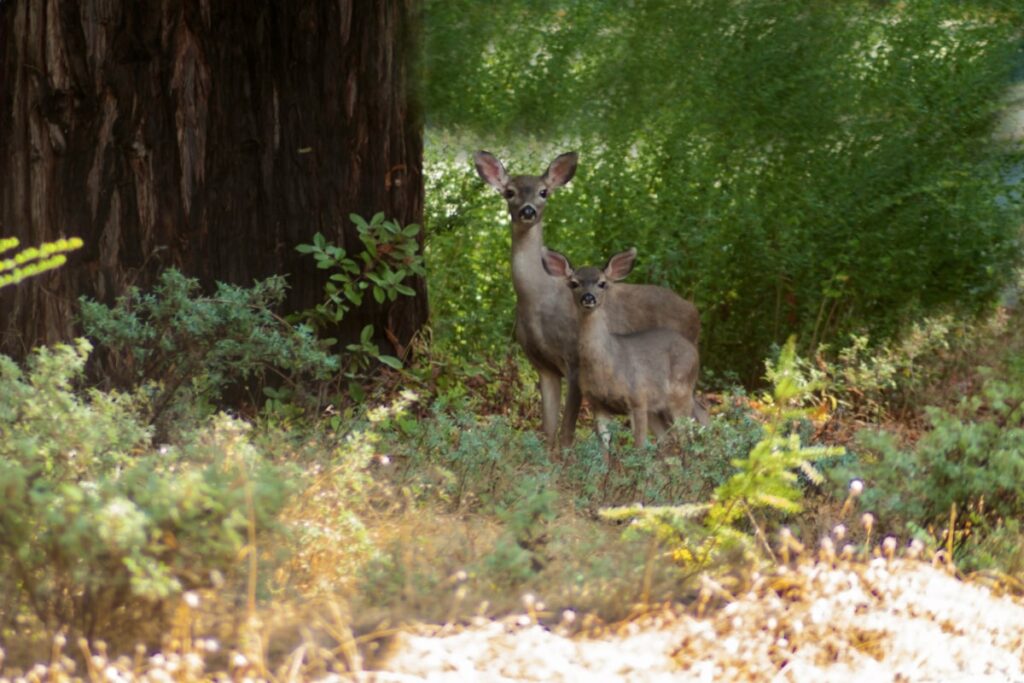
May is a great time to visit, as temperatures are mild and the park’s flora is in full bloom.
Key Spots and Wildlife Encounters
Avenue of the Giants: Drive this scenic route and look for black-tailed deer, Roosevelt elk, and various bird species.
Founders Grove: Wander through the towering redwoods and search for banana slugs, woodpeckers, and marbled murrelets.
Eel River: Spot river otters, beavers, and various waterfowl along the riverbanks.
Quick Tips
Join a guided nature walk to learn more about the park’s unique ecosystem and its inhabitants.
Practice responsible wildlife viewing by maintaining a respectful distance and adhering to Leave No Trace principles.
Hagerman Wildlife Refuge (Texas)
Hagerman Wildlife Refuge, situated along the shores of Lake Texoma, is a haven for birdwatchers and wildlife enthusiasts alike.

May is an ideal time to visit, as migratory birds pass through and the refuge’s wildflowers are in bloom.
Key Spots and Wildlife Encounters
Goode Day Use Area: Observe waterfowl, shorebirds, and songbirds along the lakeshore.
Meadow Pond: Look for white-tailed deer, raccoons, and various bird species around this secluded pond.
Wildlife Drive: Drive this scenic route for encounters with wild turkeys, coyotes, and a variety of bird species.
Quick Tips
Attend a ranger-led bird walk or wildlife tour for expert insights on the refuge’s inhabitants.
Bring binoculars and a field guide for better bird identification and viewing opportunities.
Assateague Island National Seashore (Maryland, Virginia)
Assateague Island National Seashore is famous for its wild horses, which roam the island’s beaches, dunes, and marshes.

May is an excellent time to visit, as the weather is mild and the island’s migratory birds arrive.
Key Spots and Wildlife Encounters
Life of the Dunes Trail: Observe wild horses, Sika deer, and a variety of bird species along this sandy trail.
Tingles Island: Look for waterfowl, shorebirds, and nesting ospreys in the marshy areas.
Assateague Lighthouse: Spot various bird species, including herons, egrets, and red-winged blackbirds, near this historic landmark.
Quick Tips
Join a guided horse-viewing tour or birdwatching program for expert insights and increased wildlife viewing opportunities.
Maintain a safe distance from the wild horses and follow park guidelines to ensure a positive experience for both you and the animals.
Channel Islands National Park (California)
Channel Islands National Park consists of five islands, each with its own unique ecosystem and wildlife, such as island foxes, sea lions, and various bird species.
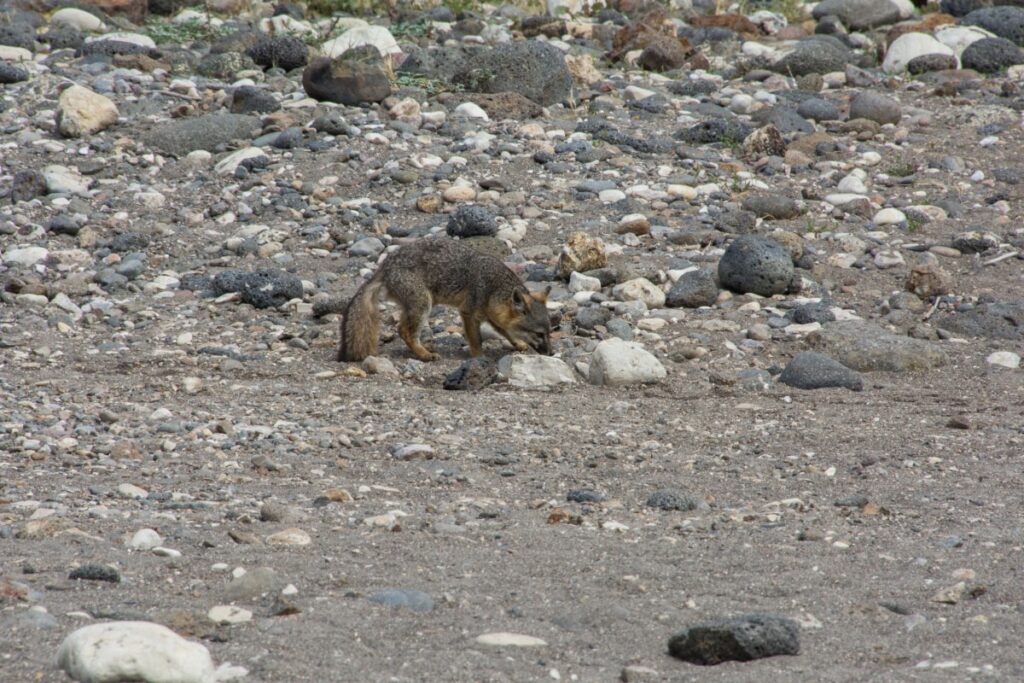
May is a great time to visit, as the park’s wildflowers are in bloom and migratory birds pass through.
Key Spots and Wildlife Encounters
Anacapa Island: Observe western gulls, brown pelicans, and various seabirds nesting on the island’s cliffs.
Santa Cruz Island: Look for endemic island foxes, scrub-jays, and various bird species in the island’s diverse habitats.
Santa Rosa Island: Spot elephant seals, sea lions, and harbor seals lounging on the island’s beaches.
Quick Tips
Book a guided wildlife tour or ranger-led program for expert insights on the park’s unique ecosystems and inhabitants.
Bring binoculars and a field guide for better wildlife viewing and identification opportunities.
Congaree National Park (South Carolina)
Congaree National Park, home to the largest intact expanse of old-growth bottomland hardwood forest in the southeastern United States, supports diverse wildlife such as white-tailed deer, river otters, and various bird species.
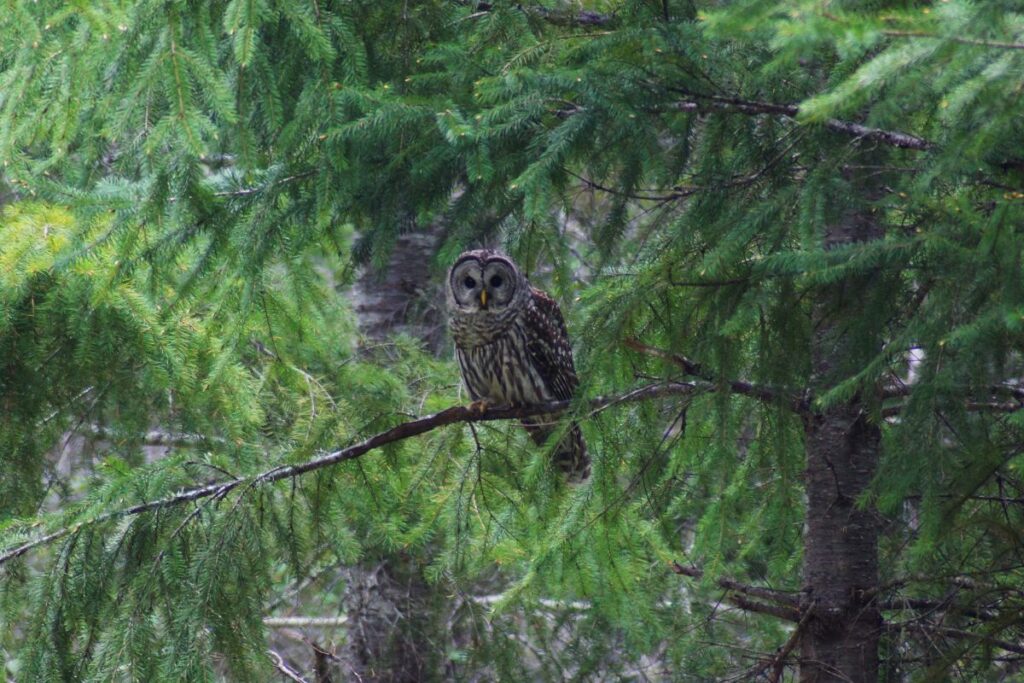
May is an excellent time to visit, as the park’s flora is vibrant and migratory birds arrive.
Key Spots and Wildlife Encounters
Boardwalk Loop Trail: Observe white-tailed deer, barred owls, and various songbirds in the park’s diverse habitats.
Cedar Creek: Canoe or kayak along the creek to spot river otters, turtles, and a variety of wading birds.
Bates Old River: Look for woodpeckers, herons, and egrets in this secluded section of the park.
Quick Tips
Join a guided nature walk or birdwatching program for expert insights on the park’s wildlife and ecosystems.
Use insect repellent and wear long sleeves to protect against mosquitoes.
Read More: CONGAREE NATIONAL PARK: CLOSE TO HOME YET UNDERRATED (THINGS TO DO INCLUDED)
Shenandoah National Park (Virginia)
Shenandoah National Park’s picturesque Blue Ridge Mountains are home to a variety of wildlife, including black bears, white-tailed deer, and over 200 bird species.
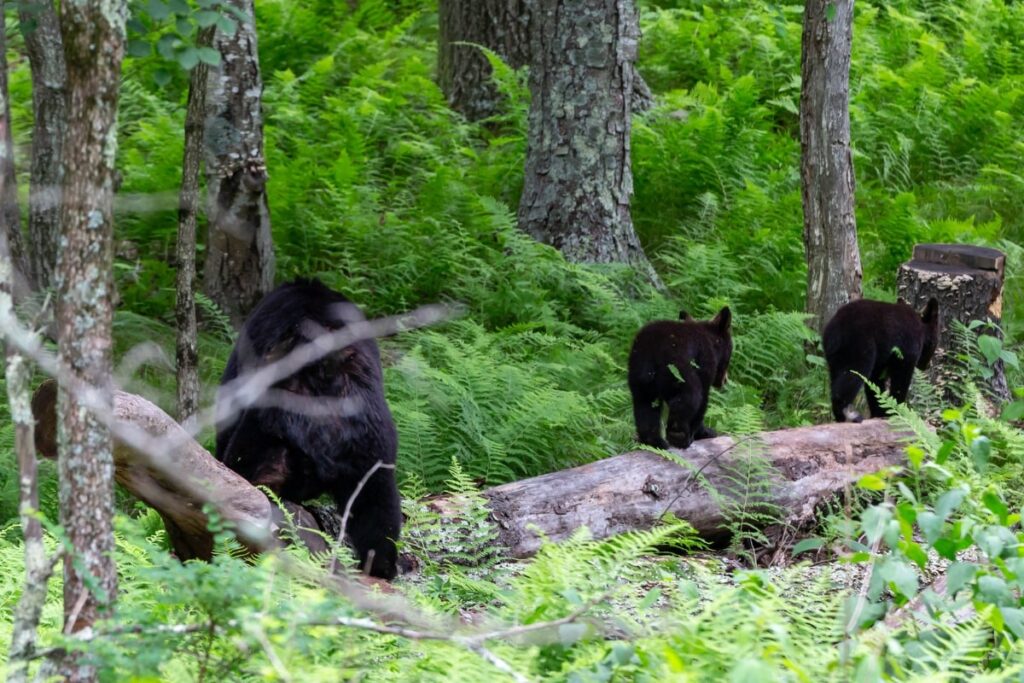
May is a fantastic time to visit, as the park’s wildflowers bloom and migratory birds arrive.
Key Spots and Wildlife Encounters
Skyline Drive: Drive this scenic route to spot black bears, white-tailed deer, and a variety of bird species.
Big Meadows: Observe black bears, white-tailed deer, and wild turkeys grazing in this expansive meadow.
Limberlost Trail: Look for woodpeckers, warblers, and various songbirds along this accessible trail.
Quick tips
Attend a ranger-led program or guided wildlife tour for expert insights on the park’s inhabitants.
Practice responsible wildlife viewing by maintaining a respectful distance and adhering to Leave No Trace principles.
Conclusion
By now, you should be inspired to embark on your next wildlife adventure! The United States boasts an incredible variety of parks and forests, each offering unique opportunities for animal encounters and outdoor experiences.
Whether you’re a seasoned wildlife enthusiast or a casual observer, this list of 20 destinations should provide plenty of inspiration for your May travels.
So, pack your bags, gather your gear, and prepare to create lifelong memories as you immerse yourself in the beauty of America’s wild side.

